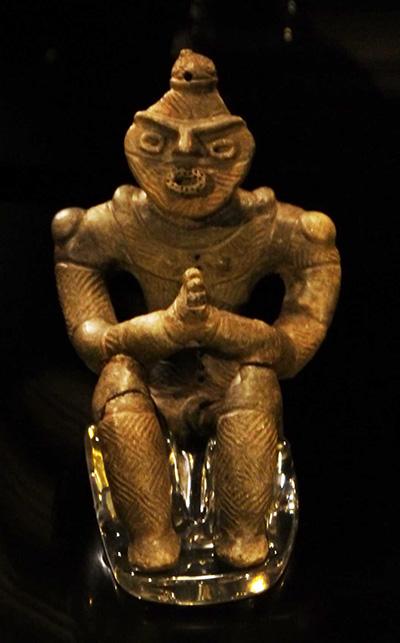
日本列島の北の方ではこの話題、長年の宿願でした。
わたしもその推進市民運動に賛同しておりましたが、宿願達成。
以下、NHKのWEBニュースから要旨。
〜世界文化遺産への登録を目指している北海道・北東北の縄文遺跡群について、
ユネスコの諮問機関は26日、世界遺産への登録勧告をまとめた。
これにより世界文化遺産に登録される見通しとなりました。
北海道・北東北の縄文遺跡群は北海道と青森県、岩手県、秋田県に点在する
17の縄文時代の遺跡で構成されています。
狩猟や採集、漁労を基盤に人々が定住して集落が発展し、
1万年以上続いた縄文時代の生活や精神文化を現代に伝えるもので
普遍的な価値があるとしています。
構成する17の遺跡がすべてことし7月に開かれる世界遺産委員会で
正式に世界文化遺産に登録される見通しとなりました。
農耕を伴わない定住生活や複雑な精神文化を示していると評価された。〜
まったく喜ばしい限りであります。
できれば日本史の記述でもこの歴史事実をベースにより深化を希望。
人類の世界進出、およそ7万年とも8万年とも言われるけれど
出アフリカから日本列島に至って、海に面した豊かな漁撈資源を基礎に
それまでの移動生活から大変化し16,000年前ころ定住が開始された。
広く普遍的に非農耕型の暮らし方が営まれてきた。
縄文の都と言われる三内丸山では3,000を越える
居住住居痕跡が発見され、クリなどの栽培痕跡も注目されている。
そういった暮らし方が列島では継続して営まれてきた。
やはり真正な「原日本人」といえるのではないかと思います。
写真は八戸周辺の是川縄文館に展示されている合掌土偶ですが、
わたしたちの感受性の底深くにこのような精神性があると思う。
両手を合わせるというのは、人類本然的に「祈る」こころに通じると思う。
縄文の「思想」として採集型生活基盤から自然への感謝の心が
この列島社会の基本精神としてあり続けてきたのだと思う。
すべての基本である食においてこの列島社会では
遺跡住居でも古民家住居でも一様に「鍋食文化」がベースだと言える。
縄文という文化が独特の土器で代表されていることからもこれは明らか。
食文化の基本は海産物の「うまみ」に採集植物が掛け合わされたもの。
縄文からの人間の文化を今後も丹念に掘り起こしていって
この列島での生き方、暮らし方を「日本史」の基盤として
追体験していくべきなのだろうと思います。
遺跡や古民家探究はわたしの「ライフワーク」化してきましたが、
現代の高断熱高気密にまで至る定住の営為を今後も手掘りしていきたい。
English version⬇
[To Hokkaido&North Tohoku “Jomon Ruins” World Heritage Registration]
In the northern part of the Japanese archipelago, this topic has been a long-cherished desire.
I also agreed with the promotion civic movement, but I achieved my wish.
The following is a summary from NHK’s WEB news.
~ About the Jomon Archaeological Sites in the northeastern part of Hokkaido, which is aiming to be registered as a World Cultural Heritage
A UNESCO advisory body has put together a recommendation for registration as a World Heritage Site on the 26th.
As a result, it is expected to be registered as a World Cultural Heritage Site.
The Jomon archaeological sites in the northeastern part of Hokkaido are scattered in Hokkaido, Aomori, Iwate, and Akita prefectures.
It is composed of 17 Jomon period ruins.
People settled on the basis of hunting, gathering, and fishing, and the village developed.
It conveys the life and spiritual culture of the Jomon period, which lasted more than 10,000 years, to the present day.
It has universal value.
All 17 archaeological sites that make up this year will be held at the World Heritage Committee in July.
It is expected to be officially registered as a World Cultural Heritage Site.
It was evaluated as showing a sedentary life without farming and a complex spiritual culture. ~
As far as I am very pleased.
If possible, I would like to deepen the history of Japan based on this historical fact.
It is said that human beings have entered the world for about 70,000 or 80,000 years.
From Africa to the Japanese archipelago, based on the abundant fishing resources facing the sea
It became difficult from the mobile life until then, and the settlement started around 16,000 years ago.
A wide and universal non-agricultural way of life has been practiced.
Over 3,000 in Sannai Maruyama, which is said to be the capital of the Jomon period
Traces of residential dwellings have been discovered, and traces of cultivation such as chestnuts are also attracting attention.
Such a way of life has continued to be practiced in the archipelago.
I think it can be said that it is a genuine “original Japanese”.
The photo shows the gassho clay figurines exhibited at the Korekawa Jomonkan around Hachinohe.
I think there is such a spirituality deep in our sensitivity.
I think that putting both hands together leads to the heart of “praying” in nature.
As Jomon’s “idea”, a feeling of gratitude for nature from a collection-type living foundation
I think it has continued to be the basic spirit of this archipelago society.
In this archipelago society in all the basic foods
It can be said that the “pot food culture” is the basis for both archaeological dwellings and old folk house dwellings.
This is clear from the fact that the Jomon culture is represented by unique pottery.
The basis of food culture is the seafood “umami” multiplied by collected plants.
We will continue to carefully dig up the human culture from the Jomon period.
Using the way of life and way of life in this archipelago as the basis of “Japanese history”
I think we should relive it.
The quest for archaeological sites and old folk houses has become my “lifework”,
I would like to continue to dig up the settlement activities that lead to modern high heat insulation and high airtightness.
Posted on 5月 30th, 2021 by 三木 奎吾
Filed under: 住宅マーケティング, 日本社会・文化研究







コメントを投稿
「※誹謗中傷や、悪意のある書き込み、営利目的などのコメントを防ぐために、投稿された全てのコメントは一時的に保留されますのでご了承ください。」
You must be logged in to post a comment.